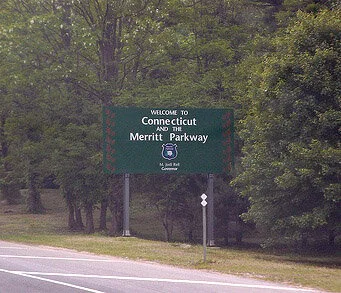
Chris Powell: Mass transit can be tough to do in suburbia
Entering the Merritt Parkway, which serves mostly suburban Fairfield County.
Highway tolls aren't the only objection to Connecticut Gov. Ned Lamont's transportation-infrastructure plan. Now that the Democratic majority caucus in the state Senate seems to have blocked tolls for another year or two, there are also complaints about how the governor recommends spending whatever money still can be raised for transportation.
Some people say the governor mistakenly emphasizes highway widening over mass transit and that the "bottlenecks" he wants to remove can never be removed because "if you built it, they will come" -- that new traffic eventually will materialize to clog whatever highways are widened.
There is some truth to that, but it is not dispositive. For if increased traffic really should disqualify highway construction, the Boston Post Road, U.S. Route 1 northeast from New York, never could have been more than a footpath, never widened for wagons and paved, and the mail between the two cities forever would have had to be carried by boat through Long Island Sound and around Cape Cod.
Politically incorrect as it may be, population growth almost always will require road construction and widening, and it will always be a matter of judgment as to how much crowding and traffic signify too much growth.
Of course just as when you're a hammer, everything looks like a nail, when you're a roadbuilder everything looks like it needs paving, and most of the recent support for tolls in Connecticut came from construction businesses and labor unions that stood to receive most of the toll revenue and so were indifferent to which forms of transit might be best. Roadbuilding can get out of control, as it did in New York City in the 1950s and ‘60s during the tenure of the now-infamous parks, bridge, and tunnel commissioner Robert Moses, though the city, being so densely populated, was perfect for expanding mass transit. As a result ,construction of the Second Avenue subway line has been nearly a century behind schedule.
Today the transit dilemma identified by the governor's critics arises mostly where city and suburb meet -- where population density falls below the level needed to prevent mass transit from operating at an impossible deficit. Unfortunately, that's Connecticut for you -- largely suburban. Rebuilding the railroad line between Hartford and New Haven just cost the state and federal governments almost $800 million and each passenger's one-way trip incurs a grotesque operating cost of almost $60 even as the price of a ticket is only $8.
Mass transit works best where it is comprehensive -- where travelers don't need a car at either end of the line or where there is commuter parking at one end and the last leg of the trip is short. That is often the case in lower Fairfield and New Haven counties, along the Metro-North commuter railroad, the busiest such railroad in the country, but not in the rest of the state, which still needs roads more than rails.
Another complaint made lately in regard to tolls is that people in Connecticut think that highways should be free. But they don't really. Rather they are realizing that they have been paying for highways through fuel and related taxes while much of the revenue has been diverted to state employee pensions and other irrelevant purposes.
Connecticut could greatly reduce its transportation-infrastructure needs if it ever reduced poverty in its anarchic cities enough that middle-class people wanted to live there again. But maintaining poverty here is a bigger business than maintaining the roads and rails and it can't be questioned in polite company.
Chris Powell is a columnist for the Journal Inquirer, in Manchester, Conn.
A streetcar named reasonable
People like to call most new large public projects boondoggles, but if politicians followed such negativism religiously,very few useful public projects would be built and the public would find life much more difficult. Yes, even Boston's Big Dig was worth it.
So it is with the idea of putting in a streetcar line in Providence. With the city's thick downtown density, large numbers of college students without cars and an aging population not driving as much these days, I think that the line would do very well in improving the city's economy and quality of life. The rich cities to our north (Boston) and south (New York) owe much of their prosperity to mass transit.

